Modern requirements for wiring
Electric installation work
So, today the requirements are made directly to the installation of electrical wiring, as well as to the choice of cable cross-section, ratings of protective automation and wire connection method. We’ll take a closer look at what this is said in regulatory documents.
Let's start with the requirements for the installation of electricians, as Based on these points, you can determine the method of laying the cable and the choice of materials necessary for this.
- According to chapter 7.1. PUE, namely, clause 7.1.13, the power supply of a residential building should be made from a network with a voltage of 220 or 380 Volts. In this case, the grounding system must be TN-S orTN-C-S.
- Installation of open wiring allowed to perform in special cable channels, trays or electrical skirting boards. In damp rooms (for example, baths) and wooden houses, you can mount electrical wiring on insulators.
- The laying of hidden electrics is carried out in ceilings, voids of building structures (in apartment buildings), as well as directly in the walls. The main requirement is that with hidden wiring, the cable line must run through fireproof structures. This is especially true when installation of electrical wiring in a wooden house and a bathhouse.
- According to the PUE chapter 7.1. Section 7.1.34, you must use copper wires. Aluminum wires are allowed only with a cross section of 2.5. sq. mm for connecting individual electrical appliances from engineering equipment, and in all other cases from 16 square meters. mm for example for connecting electricity from the pillar to the house.
- Wires must have color marking and fit her.
- If the cable is armored, it is allowed to pass through the walls without the use of tubes or metal sleeves.
- Unprotected insulated wires (without an additional sheath) may be laid through external walls in pipes made of polymer materials. Moreover, in dry rooms at the end of the pipe must be installed insulating sleeve.
- It is forbidden to conduct phase and neutral wires in different steel pipes if the continuous load current is more than 25A.
- Lay the wiring only strictly vertically and horizontally.Installing electricians in the shortest way not only violates the general requirements for electrical installation, but also puts your life at risk (increases the chance of getting into electrical wiring when drilling walls).
- The apartment shield, in fact, like the electricity meter itself, must be installed at a height of 80-170 cm from the floor. According to PUE 1.5.29 (Chapter 1.5) is the permissible height of the clamps of the meter. Such a height will prevent children from accessing the electrical panel, as well as accidental mechanical damage. About the rest installation requirements You can find out in our corresponding article.
- It is forbidden to lay electrical wiring on heated surfaces, including near fireplaces, chimneys and stoves. This requirement is especially relevant for baths and saunas.
- It is possible to carry out electrical work at a temperature not lower than -15 ° C. This is due to the fact that each cable has maximum allowable operating temperatures and installation temperatures. In the cold, the insulation is tanned and can crack when bent, read more information on each of the brands in the section on cable products: https://my.electricianexp.com/en/elektroprovodka/provoda-i-kabeli.
- The rating of the sockets must be 16A and higher, while all sockets must be earthed.
- In humid rooms, the degree of protection of sockets against moisture and dust should not be lower than IP44. This requirement is relevant for bathrooms, baths, kitchens (if the outlet is installed near the sink), and even attics.
- Minimum height of installation of sockets from a floor should be 30 cm.
- Each room must have at least one lighting point. At the same time, the requirement for outdoor lighting - at least one lamp should be at each exit from the house, garage, other buildings.
- A separate wiring line from the panel should go to the bathroom and the bathroom, protected not only by a circuit breaker, but also by an RCD with a rating of not more than 30 mA (according to Chapter 7.1. Of the Electrical Code of Clause 7.1.82.).
- The home network should consist of at least three groups: lighting, sockets and a separate line for connecting the hob and oven. If more powerful consumers of electricity (for example, an electric boiler) are provided, a separate line must also be provided for its power.
- At installation of electrical wiring in the floor an important requirement must be observed - no more than two turns of the cable at a right angle are allowed. This is especially true when laying electricians in the screed.
- When mounting the wall sockets in the wall, it is forbidden to use mounting foam (for reasons of fire safety). It is better to use alabaster to install undergrowth.
- When underground wiring is not allowed to conduct an electrical line under the foundation.
- It is impossible to ditch ceilings, as well as load-bearing walls represented by panels (they have voids inside).
- It is forbidden to install sconce lamps above the bathroom. The fact is that a red-hot lamp may burst upon contact with water.
- According to table 2.1.3 from the chapter 2.1. PUE in wooden houses you need to use a non-combustible cable with a low smoke emission, for example, VVGng-LS.
- It is strictly forbidden to use the PUNP wire for the installation of electrical wiring. What is the danger of PUNP wire, you can find out in our article.
That's all the basic requirements for direct electrical installation in a private house and apartment. As you can see, most of the prohibitions apply to wooden buildings. Brick houses are much simpler.
Connection of wires and selection of their cross section
I would also like to highlight several basic prohibitions that are indicated in the rules of the PUE regarding electrical wiring connections. So:
- A place branch wires (or compound) should not be subjected to mechanical stress. Insulation at the junction / branch should not be inferior to the technical characteristics of the whole insulation of the same conductors.
- The wires that will be laid inside the walls should have a margin for connecting electrical points (lamps, sockets, etc.), as well as interconnections in junction boxes of at least 5 cm.
- It is forbidden to commute the wires in the pipes. All connections must be made in non-combustible junction boxes, access to which must be free.
- According to Chapter 2.1. PUE, paragraph 2.1.21, the use of twisting is strictly prohibited. Soldering is best avoided. Of the preferred methods for connecting the cores, we recommend staying on such as quick-clamping WAGO terminals, PPE caps, welding, crimping with sleeves.
- Aluminum can only be connected with copper using terminal blocks.
This we have provided the basic requirements for electrical wiring in residential and industrial premises. We recommend that you familiarize yourself with the table in which the minimum cross-sections of the conductors for electrical installation work are indicated (paragraph 2.1.14 of the PUE):
You also need to choose the right cable cross section, focusing on the power of electrical appliances in the house or apartment. Details about calculation of cable cross-section by power and current You can find out in our corresponding article.
Finally, we recommend watching a useful video on the topic:
That's all the modern requirements for wiring in a private house and apartment. As you can see, there are a lot of nuances that need to be considered in order to do everything correctly, and most importantly - safely. Finally, we recommend that you familiarize yourself with typical wiring errors.

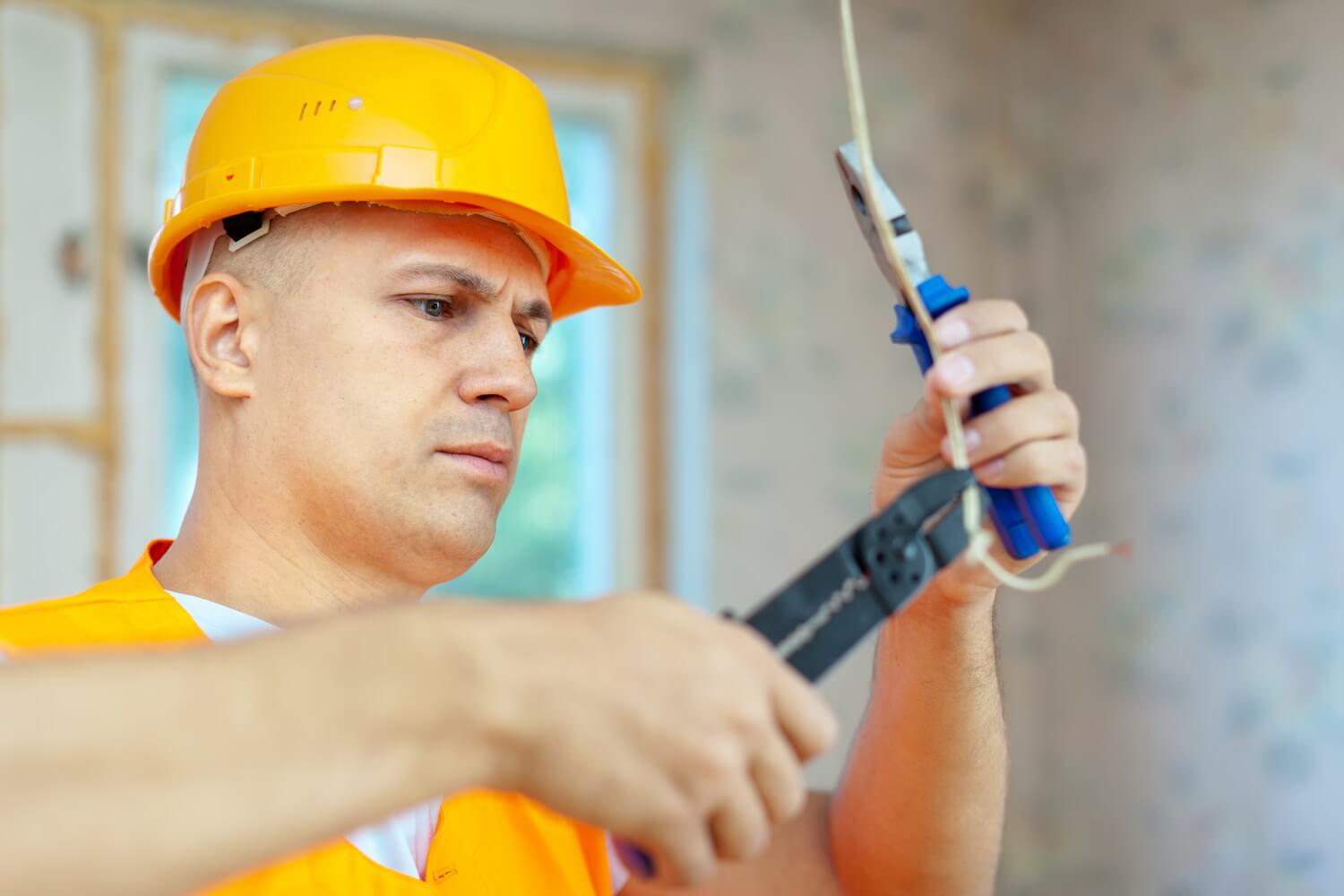
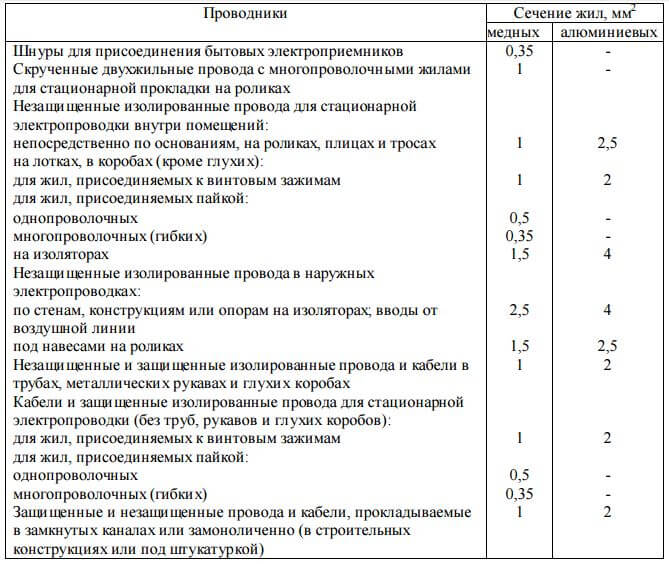


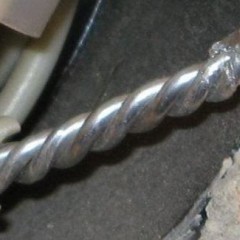
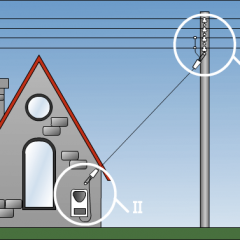
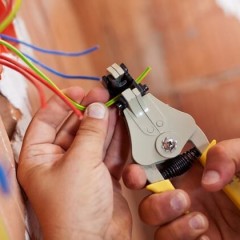

Study the SNIP, and don’t get into a heresy about welded joints, they lifted Wago after 5 years, didn’t pass the tests, and they always require visual access for revision, but they don’t need welds anymore. About tips finally nothing.
Where in the article even a word about the advantage of Wago over welding?
Strange, I have been working with WAGO for 14 years)))
Please tell me, is it allowed to do open wiring inside an apartment in an apartment block building? (it's time to change the wiring)
Hello! According to the EMP, Chapter 7.1, clause 7.1.37, the wiring must be replaceable. Those. if open, then in special skirting boards or cable channels.
Please tell me whether cable laying is permissible or not (transferring the circuit breaker from one wall to the adjacent adjacent one) as follows (pictured). Interested in laying the cable without additional general insulation.
Hello! Laying wires without a protective shell under the plaster is prohibited, we focus on GOST R 50571.15-97. Insulated wires (without sheath) can be laid in boxes, in pipes or on insulators. It is also necessary to lay the wire parallel or perpendicular to the floor / ceiling. Diagonal gasket, as in your case, is also not allowed.
GOST R 50571.5.52-2011:
Electrical wiring, rigidly fixed and embedded in the walls, should be located horizontally, vertically or parallel to the edges of the walls of the room.
522.8.8 Wiring laid in building structures without fastening may be located along the shortest path. Electrical wiring in the ceilings may be located along the shortest path.
thanks for the consultation
Order installation of three outlets. I bought the socket. An electrician from the company installed sockets without sockets on a pair of screws that are installed in the wall opening without dowels. Outlet mechanism is skewed. To my claim of installing the foreman, the foreman requires me to justify why all the rosettes are needed and refuses to carry out work to fix the installation.What GOSTs can I refer to? Attaching photo.
1. Yes, the photo shows that if you turn the socket - you pass the wire, in the leftmost socket exactly.
2. They are bolted, to put it mildly, not very.
3. You have the right to demand that all work be done from wage workers who, most likely, do not have a permit or an entrepreneur or similar documents.
4. Do not pay for such work.
5. There are such points in the PUE ”6.6.21
The requirements given in paragraphs. 6.6.22-6.6.31 apply to devices (switches, switches and sockets) for rated current up to 16 A and voltage up to 250 V, as well as on plug connections with protective contact for rated current up to 63 A and voltage up to 380 V .
6.6.22
Hidden devices must be enclosed in boxes, special enclosures, or placed in the openings of reinforced concrete panels formed in the manufacture of panels in construction industry plants. "The use of combustible materials for the manufacture of covers that cover the openings in the panels is not allowed."
That is, if the holes are not factory-made and without non-combustible substrates, the rosettes are required! If they do not read the PUE - to the neck, if you do not want a fire or electric shock!
Hello. Tell me. An increase in the quadrature of the cross section of the copper wire as a jumper from the machine to the machine. Total 6, and the jumper two by 4 and zero and phase. The regulation is written about it or not ???? SNiP, GOST or PUE !!! I would really appreciate it.
Is such an outlet allowed?
Is internal wiring permitted on the same line with outlets? If not, what rule applies to this wiring in residential apartment buildings?
Hello! Please tell me you can use the KG cable in residential premises